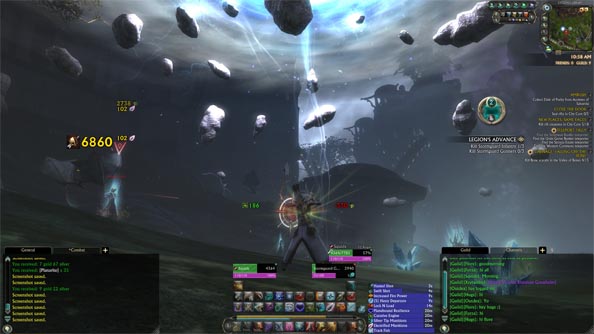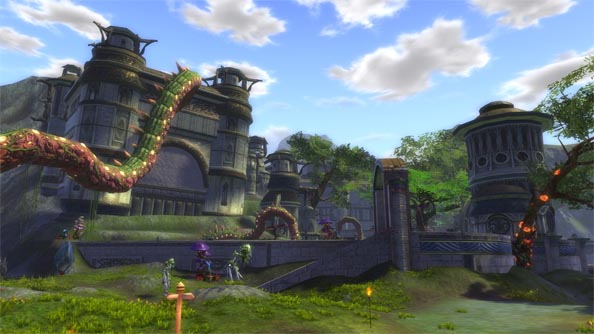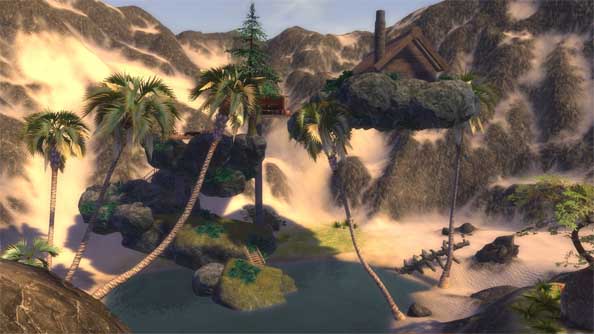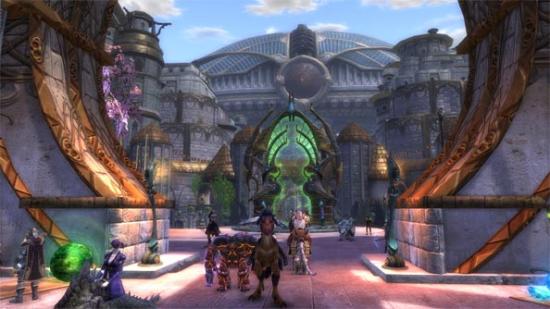Let’s talk game mechanics for a second. I’m going to echo MMO-blogger Syncaine in saying that MMO game mechanics are poor. Would you play a single game that played like a typical MMO for hours on end? Fights that – at least in the solo-parts of the game – tend to look exactly the same? Quests that send you out to do more or less the same thing, but with a different wrapping, over and over again?
In my MMO career I’ve killed more mobs for more quest givers than I want to think about. I daren’t count the pointless quests for XP and miserly rewards that will be replaced in the next zone. And I can’t imagine the the times I’ve been sat in front of the same bosses, in the same dungeons. It’s the way things work.
But you know what? I fucking love that treadmill.
Rift: Storm Legion is a perfect example of a classic MMO releasing a traditional expansion pack. It’s a great addition to the game. Why is it important?
Rift’s been quietly reinventing itself in patches and content updates since launch. Trion have been frank about the reasons for Storm Legion: they simply ran out of room on the previous continent: Mathosia. While Blizzard has always seemed happy with releasing a content patch every six months or so, Trion has been aiming at every nine weeks or so.
Storm Legion triples the size of the game. It’s an enormous expanse of new geography, split over two continents. Within those continents, Trion have been fiddling.

The zones are incredibly detailed, and filled with stuff to see and explore – from the lush rainforests of Cape Jule and bleak landscapes of Seratos to the beautiful ruins of City Core and the sprawling majesty of Tempest Bay – especially with all the quests hidden away in their nooks and crannies. Pandaria was impressive, no doubt, but why settle for a single continent when you can add two huge ones?
The first change worth examining is the way quests are presented. Quests are now spread out across the world, hidden away and not limited to quest hubs. Kill quests have, to a large extent, been changed to “carnage quests” – killing a mob with a quest marker sets off a quest to kill X more of that type of mob.
You could skip them (the rewards aren’t that good early on) but you will do them anyway. The lure of experience points and some gold is too strong to resist, even if I grumble and complain while I do them. Unless I happen to be under-leveled, they don’t even put up any challenge. But I do still do them and I love it.
Then there are the Dimensions: player owned houses. Dimensions are private spaces, instanced away from the rest of the world, where you can plonk down furniture and walls, building rooms and roofs to create your own home. They give you an opportunity to explore your own creativity, which you can then share with the rest of the world to see.
The editor itself gives you a wide degree of freedom to build what you want. Every single object that can be placed in your Dimensions can be moved, scaled and rotated to your heart’s desire. The areas are, for the most part, big (at least the more expensive ones, going for 200 platinum or more) and give you ample room to play around in. The whole thing even comes with a leaderboard, where you can vote up the Dimensions that impress you, and the ones that have made it to the top are amazing. Then there’s the challenge to find all the Dimension-items in the first place – they come from a wide variety of sources, like vendors, crafting, random drops and quests.

Rift is a good example of how to run a subscription game: you give your players their money’s worth. Trion keep the updates coming, and considering that the bad guys – the dragons – are soon all dead we’re bound to see some interesting ones coming in the future. The game is worth the $15 it cost you to play it. Bioware proved they couldn’t deliver good content patches in a timely manner (they set themselves up with that, because having to stick to the whole fully voiced-thing), and Star Wars: The Old Republic floundered down into F2P-hell because of it. Rift: Storm Legion proves that the subscription model isn’t dead, it’s just been abused by companies that don’t know what the hell to do with it.
Storm Legion has made me fall in love with Rift all over again. It’s big, it’s better, it’s filled with stuff – but if you burned out on previous offerings, or even Rift itself, and are tired of typical tab-targetting hotbar action, you should probably look elsewhere. It doesn’t have a fully voiced “fourth pillar” plotline or advanced phasing. Trion don’t try to add bells and whistles just to add bells and whistles – instead they are slowly refining their game to become a more coherent whole. At the end of the day, Rift is just an MMO that works.

Personally, I can’t play World of Warcraft because of the overdone and stale MMO game mechanics mentioned above, but Rift somehow manages to make me forget them – even when the macro-system, which allows you to queue up several abilities on a single hotbar-slot, can make the one-button pressing worse.
If you’re looking for a new MMO, or have been waiting for an opportunity to return to Rift, I’m not sure you can actually get anything better than Rift: Storm Legion right now.
